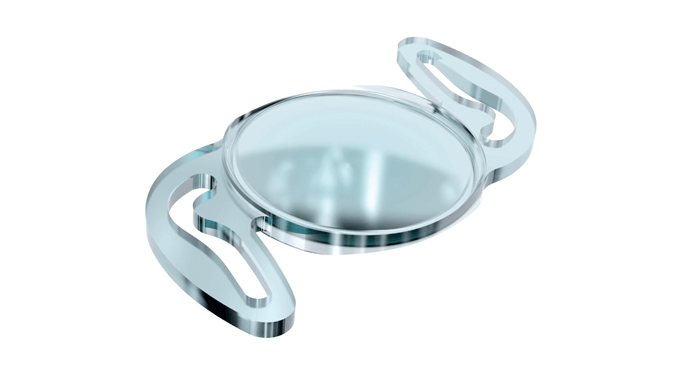
Meet Geoffrey Collett…
I’m an anterior segment surgeon with a particular interest in cataract surgery and ocular surface disease. Rayner products have only been on my radar since leaving residency, and one of the very first things I said when I started using them was, “Where were these when I was training!”
IOLs need to be easy to use while delivering dependable, repeatable results – that’s what surgeons want and need in their operating rooms. And that’s exactly what I’ve found implanting RayOne EMV. I’ve been using it for the last two years now, and I’m absolutely convinced more people need to know about it!
What is RayOne EMV and how does it work?
I’d describe it as being like a non-diffractive extended depth of focus (EDOF) IOL – even though it's not classified as such. It works by enhancing the eye's natural positive spherical aberration to extend depth of depth of focus while avoiding issues that can arise with diffractive lenses. RayOne EMV certainly achieves comparable visual outcomes to other EDOF products, and, frankly, at a much more favorable price.
How does RayOne EMV compare to standard monofocals?
Let me be direct: RayOne EMV blows a standard monofocal out of the water. When it comes to intermediate vision, I don’t think a standard monofocal really delivers. And that intermediate vision – looking at a phone, working on a computer – is so much more important now. We’ve known for a long time that distance vision is important, and that close vision is essential, but, over the last five years, we’ve all become aware that the “third zone” of vision has become vital for day-to-day quality of life. A standard monofocal simply cannot deliver intermediate vision for patients. But RayOne EMV can.

What are the visual outcomes like with the RayOne EMV?
As long as you leave someone with 0.5D or less of corneal astigmatism, the outcomes are very similar to other EDOF lenses. I’m consistently seeing 20/25 vision – with good quality in the intermediate range. I think that’s fantastic and – unsurprisingly – my patients love it too.
Do you use monovision with RayOne EMV?
What makes RayOne EMV different from other EDOF lenses is its optimization for enhanced monovision, which provides a smoother transition between focal points. I personally have been happy with my results just targeting bilateral emmetropia, but I know other surgeons who utilize monovision and get good results in near vision. I want to start trying because, if we can secure the entire range from distance to close vision, patients can only be happier!
To repeat: As long as you deal with astigmatism intra-operatively, say with a limbal relaxing incision, you can nail intermediate visual acuity targeting bilateral emmetropia. And that’s where we’ve seen the most value from RayOne EMV.
What about dysphotopsias?
Patients haven’t reported any significant dysphotopsias. As for other lenses, I feel it is a little unfair to charge patients so much when, for a lower price, we can implant RayOne EMV and perform surgical astigmatism correction.
RayOne EMV simply doesn’t have the risk profile of diffractive lenses, therefore post-operative halos or glare are of no concern.
How about delivery?
When I started training, the mechanism for inserting IOLs required both hands; I am so glad we’ve moved toward preloaded IOLs such as RayOne EMV. Its ergonomic plunger design means true single handed insertion, allowing you to keep control of the eye with your other hand.
The bevel, or tip of the plunger, is the smallest diameter on the market. I use a 2.4 mm incision with my keratome and every time it fits really nicely. The lens enters the eye smoothly and doesn’t require much manipulation, if any at all, after implantation. The delivery mechanism is the best I’ve used.
How do you position RayOne EMV within your practice?
A great question. We don’t price it at the same level as a premium lens, but we do offer the additional option of astigmatism correction as a kind of “bolt-on” option to the lens itself. We also offer femtosecond laser assisted cataract surgery (FLACS), but I don’t use FLACS that often as I can get similar results with limbal relaxing incisions when it comes to addressing corneal astigmatism.
And whether you do it with laser or manually, astigmatism management allows you to unlock the most favorable outcomes with this IOL.
From a price-point perspective, RayOne EMV opens the door for you to offer patients the solution they actually want. After explaining IOL options, I’ve never had a patient turn around and say, “I prefer what the standard lens offers.” I’ve been providing more and more EMV packages – and I only see that increasing. It’s great to be able to tell my patients that RayOne EMV will give them much more than a standard monofocal. And that’s a measurable statement; when I see my patients, the outcomes are undeniable even one day post-op.
References
- 1. Ferreira TB. Comparison of visual outcomes of a monofocal, two enhanced monofocals and two extended depth of focus intraocular lenses. Presented at ESCRS 2022
